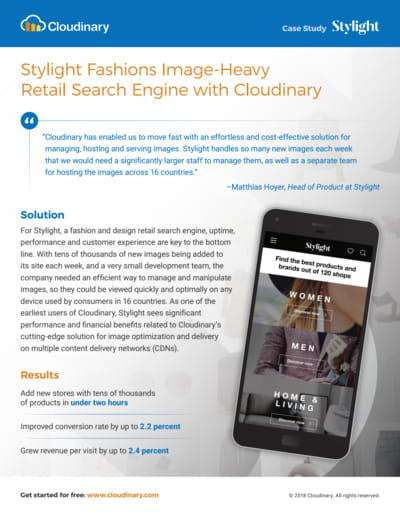Through Stylight, a search-engine in the fashion arena, shoppers can search over 1,000 shops in 16 countries and 30 million products for the best deals and be directed to retailer websites for purchases. When a new shop goes online, Stylight must add and display as many as 50,000 or more new products on its site.
Uptime, performance, and customer experience are key for Stylight’s bottom line. To manage and display its many thousands of images, Stylight needed an efficient way for transforming them for fast loading and optimal viewing on all devices.
As an early adopter of Cloudinary’s cutting-edge solution for image management and delivery on content delivery networks (CDNs), Stylight has accomplished these impressive results:
- Added new stores with thousands of products in under two hours.
- Improved the click-out conversion rate (COCR) by up to 2.2 percent.
- Grew the revenue per visit, which is tied to the compensation from partner stores, by up to 2.4 percent.
“Despite our limited manpower, we still wanted to move fast. Managing images, including transforming and optimizing them for all kinds of devices and viewports, was a challenge for our new responsive website,” said Matthias Hoyer, head of product at Stylight. “We needed an easy way to do those tasks and display images appropriately for our users.”
On-premise options would incur on-site hosting and storage costs. Instead, Stylight searched for cloud solutions and discovered Cloudinary.
“Cloudinary offered everything we were looking for—multiple image resolutions, scaling, quality optimization,” Hoyer explained. As one of Cloudinary’s first customers, Stylight implemented Cloudinary as a key component of its search engine.
Stylight’s microservices-based architecture means that the company’s teams routinely collaborate to integrate shops with the site and add product information on the fly. The team that tags products to the appropriate categories also uploads images to Cloudinary. Separately, the client-facing product team transforms images with Cloudinary’s unique URL-based solution through a RESTful API.
Cloudinary’s automation features, in particular those for format selection and quality compression, have enabled Stylight to deliver the best image format, such as WebP for Chrome browsers, and to optimize images according to viewport, bandwidth, and such. The result is “a significant positive effect on page-load time, performance, and visitor satisfaction,” Hoyer noted.
Another Cloudinary feature that is vital to Stylight is lazy loading. With Cloudinary’s lazy-loading JavaScript plugin, Stylight can determine on the server side the kind of viewing device for Stylight’s search engine and serve images in the viewport along with the correct image tags. Once the viewer interacts with the page, lazy-loading of all other images occurs.
Recently, Stylight began leveraging Cloudinary’s multi-CDN capabilities, which dynamically switch among CDNs, ensuring delivery of images closer to end-users and accelerating page loads. Such CDN switches also prevent costly downtime of the Stylight site.
Besides significant rises in COCR and revenue, Stylight has been impressive performance improvements. Lazy loading has reduced page load-time by about 100 milliseconds, translating to a superb user experience.
“Cloudinary is at the forefront of adopting cutting-edge technologies and quickly implements them. We don’t have to learn or incorporate those technologies ourselves since we know Cloudinary will do it,” Hoyer noted, adding that, as a result, Stylight can continue to operate with a slim staff.

